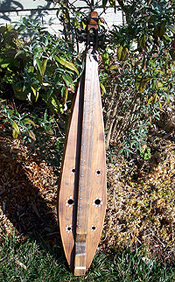HISTORY OF THE DULCIMER
The Mountain Dulcimer is a true American instrument. It dates back to the early 1800's, originating in the Appalachian mountains of southwest Virginia.
Western Europe had many kinds of fretted lap zithers from the Norwegian Langeleik, the Swedish Hummel, and the French Epinette. But it is the German Scheitholtz that is considered to be the forefather of the modern Dulcimer.

The German Sheitholtz is a long narrow instrument with straight sides. It has 3 strings on which the melody is fretted and the frets are embedded directly into the top of the instrument. Plus there are 6 other strings that make up 3 chords of 2 strings each being the 1-4-5 chords. These chords were played individually. Thus there was a total of 9 strings on the Scheitholtz.
German immigrants brought their Scheitholtz with them when they settled in Pennsylvania. The Scheitholtz then worked its way down south along the Philadelphia Road into Virginia. Here a Scheitholtz was place on a larger sound box providing a transition between the Scheitholtz and the Dulcimer. It was further south along the Wilderness Road in southwestern Virginia that the Dulcimer we know today was born. Someone experimented with the Scheitholtz and simplified it. They took just the fretted fingerboard of the scheitholtz and put it on a larger sound box. They eliminated the 3 chords and just used 2 drone strings constantly played forming a major chord. These Virginia dulcimers were teardrop shaped with 4 strings (2 melody strings and 2 drone strings).

Later after the Civil War, the Dulcimer found its way further along the Wilderness Road into West Virginia and Kentucky. By the maker's preference, they started making Dulcimers hourglass shaped with 3 strings (1 melody and 2 drones). The West Virginia Dulcimer was a wide hourglass while the Kentucky Dulcimer was much more narrow. Eventually, the Dulcimer made its way into all of Appalachia including the Carolinas and Tennesee. Each maker added his own flair and sound hole pattern.
The Appalachian Mountains were settled by the British, the Scottish, and the Irish. These people claimed the Dulcimer as their own even though they never had a musical instrument like the Mountain Dulcimer back home in the British Isles. That is why so many British, Scottish, and Irish tunes are played on the Dulcimer.

In the mountains, this new instrument was given the name of "Dulcimore" (later changed to Dulcimer). Dulcimer comes from the Greek meaning "sweet song". Not to be confused with the much earlier hammered dulcimer (which is a Persian instrument called a Santur and is the forefather of the piano). Both were named for the sound they produced and not any relationship. Thus the Mountain Dulcimer with its sweet sound was perfect for playing the old-time tunes of the mountains.
|
Sources: "Appalachian Dulcimer Traditions"
by Ralph Lee Smith
Scarecrow Press, Publishers |
"Southern Dulcimer"
by Wayne Erbsen
Native Ground Music, Publishers |